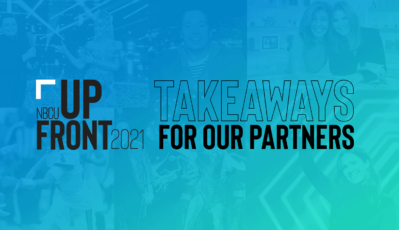June 14, 2021 | Authored By

This was the first Upfront of a new age. A watershed moment and a clear signal that everything has changed.
The marketplace has finally converged and permanently shifted. We’ve seen universal acceptance of trading principles that were unthinkable just a few short years ago: the commitment to meet our consumers where they are, across all screens; the understanding that we can create scaled and customized solutions globally, nationally, and locally; and the need for context, culture, and connection at a time when it’s so easy to be pulled apart. And across the industry, new technologies are being adopted and leveraged like never before.
For decades the Upfront was your single access point to the most sought-after premium content. The takeaways were time-bound: A season. A schedule. A narrow glimpse of consumer behavior. But today, the Upfront has a broader, more meaningful role. It’s still your first look at the incredible, most powerful content being created, but now it’s also paired with insights into the cultural and technological trends shaping our lives.
Rather than sit leaders on opposite sides of the negotiating table, the Upfront now allows us to stand side-by-side as we architect a plan for the future. Most importantly, the Upfront didn’t transform because we decided it would. It evolved because everything around it has transformed. There was no other choice. Consumers have demanded an entirely new reality and the Upfront finally reflects that.
Of course, we’ve all experienced shifts in our industry before. Having had a front row seat to two major media mergers, I’ve seen what happens when they fail—and when they succeed. And we all remember when our industry adopted the portfolio model a few years ago. That major operational shift absolutely changed the way the market thought about every media company But it’s nothing compared to the seismic technological and philosophical shift we’ve seen across our industry this year.
And yet, there’s still work to do. Up next, we need trusted partners who value transparency and are willing to amp up their data strategies and adopt higher standards. We need to chisel away at legacy and free ourselves from the limitations of the calendar. And we need to demand accountability and measurement independence.
But this year, the advertising industry can be proud that we’re moving towards an environment that’s on-demand and easy-to-access, where our work together truly reflects the future our consumers have already created. With the old report cards thrown away, and a new foundation laid–we’ve finally broke through. That’s definitely worth acknowledging. And it could not come at a better time.
Transformation is happening in every corner of the business community. From electric cars driving change in the automotive industry, to tele-health reshaping the connection between patients and providers, to reopening stores and restaurants and movie theaters—in every sector, massive shifts are shaping a new future right in front of us. How lucky we are—in this media and entertainment industry—to have this new Upfront paradigm and a truly converged marketplace to help support all that transformation.
Evolution is not dramatic or instant, and this moment was a welcome reminder that sometimes a new way forward is better than one shiny new object. We don’t always need to be inventors to be innovating. In the next year and for years to come, we can keep perfecting the parts of the Upfront that still matter, and amplify what works for consumers with the newest, best technology available to us. We can push for a greater, more inclusive, more representative, smarter, faster, and better future. And we can keep transforming our organizations to have “Upfront conversations”—all year round.
That’s the futures business we’re in—and the future we’re building together.





